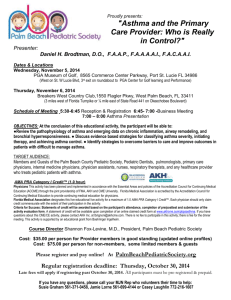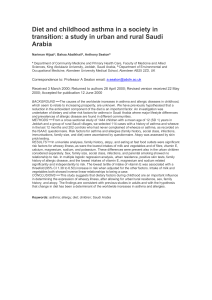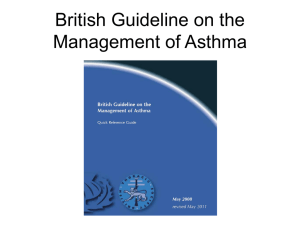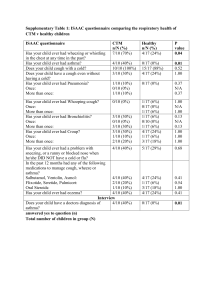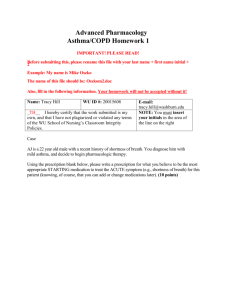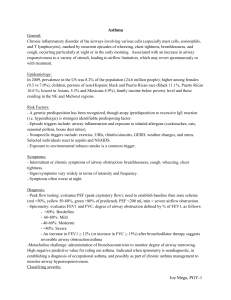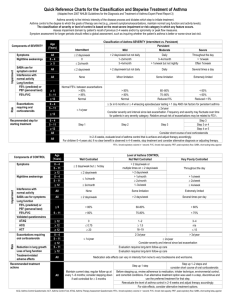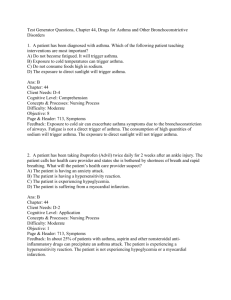File - The Free Clinic
advertisement
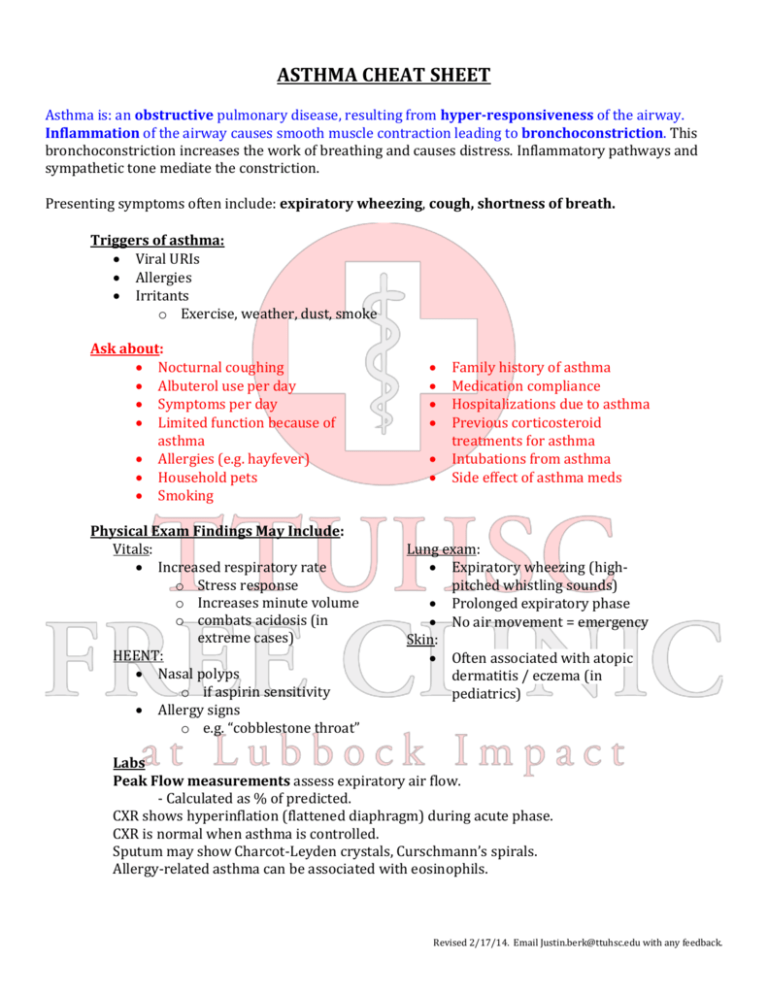
ASTHMA CHEAT SHEET Asthma is: an obstructive pulmonary disease, resulting from hyper-responsiveness of the airway. Inflammation of the airway causes smooth muscle contraction leading to bronchoconstriction. This bronchoconstriction increases the work of breathing and causes distress. Inflammatory pathways and sympathetic tone mediate the constriction. Presenting symptoms often include: expiratory wheezing, cough, shortness of breath. Triggers of asthma: Viral URIs Allergies Irritants o Exercise, weather, dust, smoke Ask about: Nocturnal coughing Albuterol use per day Symptoms per day Limited function because of asthma Allergies (e.g. hayfever) Household pets Smoking Physical Exam Findings May Include: Vitals: Increased respiratory rate o Stress response o Increases minute volume o combats acidosis (in extreme cases) HEENT: Nasal polyps o if aspirin sensitivity Allergy signs o e.g. “cobblestone throat” Family history of asthma Medication compliance Hospitalizations due to asthma Previous corticosteroid treatments for asthma Intubations from asthma Side effect of asthma meds Lung exam: Expiratory wheezing (highpitched whistling sounds) Prolonged expiratory phase No air movement = emergency Skin: Often associated with atopic dermatitis / eczema (in pediatrics) Labs Peak Flow measurements assess expiratory air flow. - Calculated as % of predicted. CXR shows hyperinflation (flattened diaphragm) during acute phase. CXR is normal when asthma is controlled. Sputum may show Charcot-Leyden crystals, Curschmann’s spirals. Allergy-related asthma can be associated with eosinophils. Revised 2/17/14. Email Justin.berk@ttuhsc.edu with any feedback. Classification of Asthma Intermittent Mild Moderate Severe Symptoms <2 days / wk >2 days/wk Daily Throughout day Inhaler use <2 days / wk >2 days/wk Daily Multiple per day Nighttime awakening 1 / month 3 / month 1 / week Every night - Minor limitation Some limitation Extremely limited Normal FEV1 < 80% FEV1/FVC: reduced 5% FEV1 < 60% FEV1/FVC: reduced >5% Activity PFTs Normal *PFT = pulmonary function tests Treatment Steps of Asthma “Rescue inhaler” = short-acting Beta agonist = SABA = Albuterol If SABA used >2 days a week, asthma is uncontrolled: Step Up treatment. STEP TREATMENT EXAMPLE NOTE β- agonists decreases smooth muscle #1 Rescue inhaler (SABA) Albuterol constriction - Steroids decrease inflammation Beclomethasone, #1 + inhaled (inactivate NF-KB) #2 Fluticasone, corticosteroid - Instruct patient to brush teeth after Budesonide corticosteroid use to avoid thrush Combination therapy: #2 + Long b-agonist Salmeterol, #3 Advair (Fluticasone + Salmeterol), (LABA) formoterol Symbicort (Budesonide + Formoterol) #3 + Leukotriene Can relieve symptoms of seasonal #4 Montelukast receptor antagonist allergies #5 #4 + Increase dose of corticosteroids. * #6 Add oral corticosteroids Prednisone *Can also consider Omalizumab (anti-IgE) at Step 5, but it is very cost prohibitive **Items in Red available at the Free Clinic. Other USMLE asthma drugs include: theophylline (PDE-I), ipratropium (muscarinic antagonists), cromolyn (blocks mast cell cytokines), Zileuton (5-LPO inhibitor). Revised 2/17/14. Email Justin.berk@ttuhsc.edu with any feedback.



